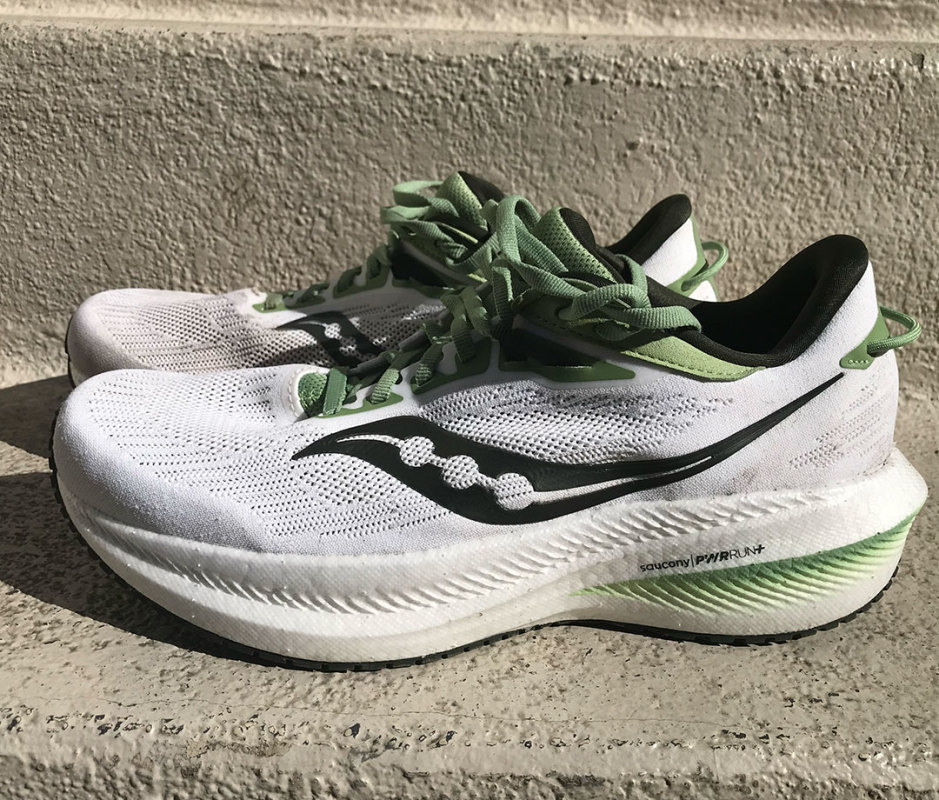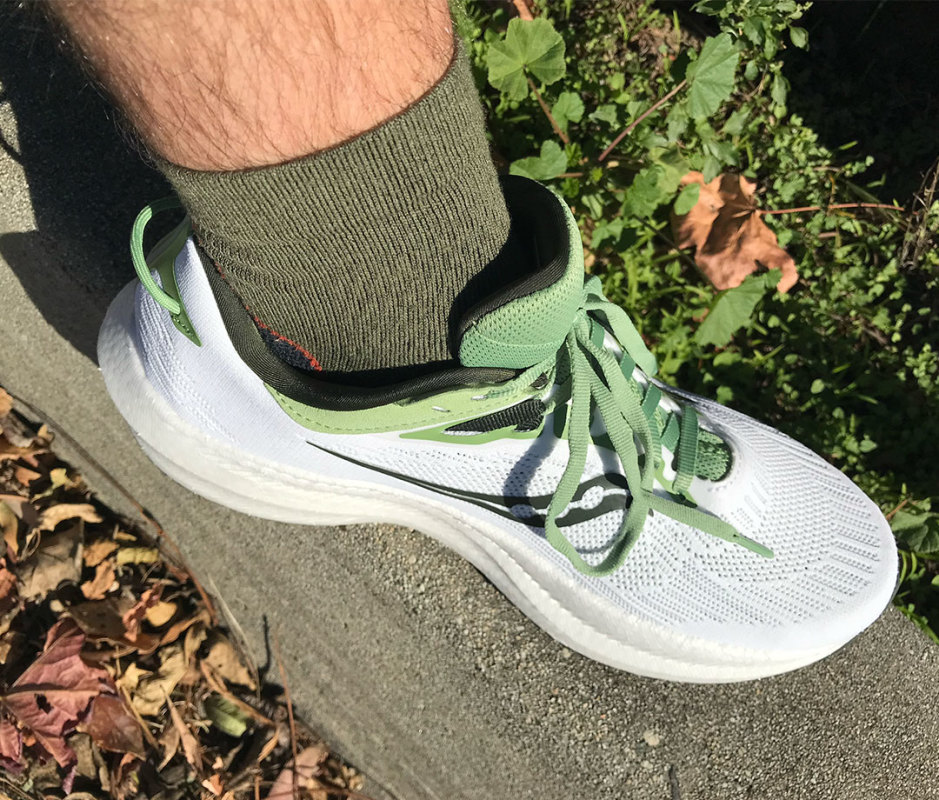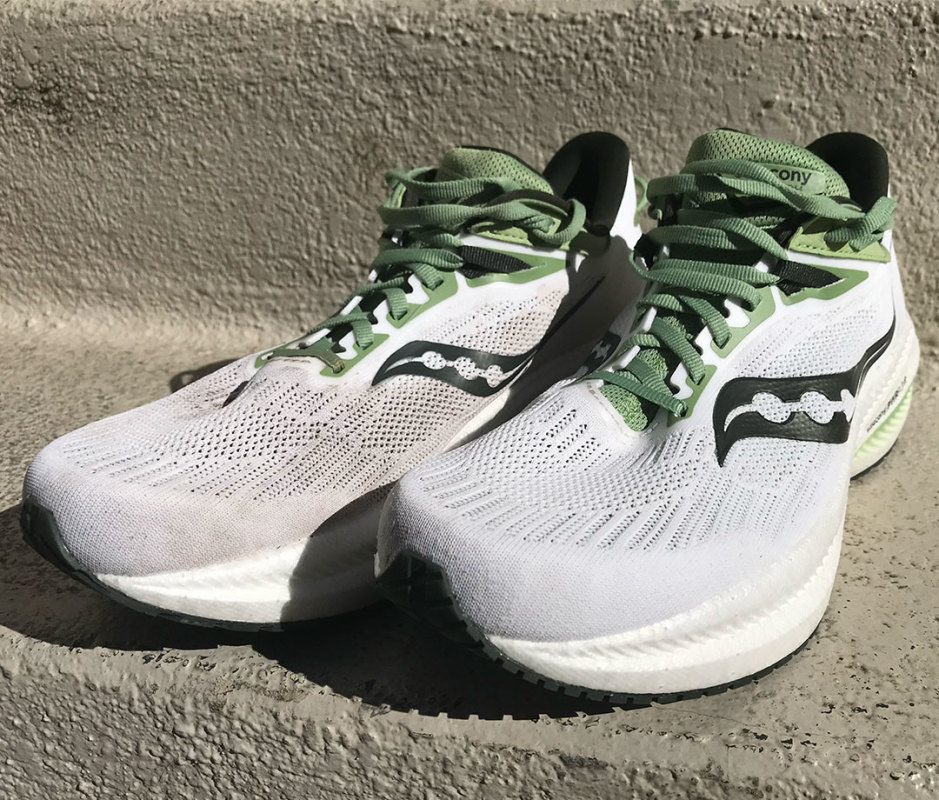In the running shoe world, big, thick midsoles full of ultra-plush cushioning foam are all the rage right now (think Hoka running shoes). Saucony Triumph 21, the latest iteration of the brand’s max-cushion everyday training shoe, falls squarely in that category.
Triumph 21 is a max-cushion workhorse training shoe. It’s designed for high-mileage durability and suitable for runners of all experience levels who like a plush feel underfoot.
Men’s Journal aims to feature only the best products and services. We update when possible, but deals expire and prices can change. If you buy something via one of our links, we may earn a commission.
Overall Impressions
Compared to some of its puffed-up competitors, Saucony Triumph 21 offers a more restrained take on maximalism. It has plenty of cushioning, of course, but it’s not so soft that it saps your energy.
After a couple weeks of testing, I’ve come to appreciate its well-balanced ride and accommodating, comfortable fit.
Ultimately, I think it can suit a wide range of runners and paces.
| Specs |
|---|
|
Weight: 9.8 oz |
|
Stack Height: 37 mm heel, 27 mm forefoot |
|
Price: $160 |

Side profile of Saucony Triumph 21 and detail shot of Pwrrun+ cushioning foam.
Michael Charboneau
Key Features and Tech
Compared to its predecessor, Saucony Triumph 21 is a subtle update, not a major overhaul.
“If you liked Saucony Triumph 20, you’ll feel at home in the Triumph 21,” Ted Fitzpatrick, Saucony’s vice president of product management & merchandising tells Men’s Journal via email. “Everything that worked underneath the foot is carried over.”
The midsole utilizes Saucony’s Pwrrun+ cushioning foam. This material is made from thermoplastic polyurethane (TPU) and, compared to older versions of the foam, it’s formulated to be less dense, which makes it softer and lighter. It’s paired with a removable Pwrrun+ sockliner for extra cushioning and bounciness with each step.
Related: We Tested Dozens of On Running Shoes. These Are the Best
The outsole is made from Saucony’s XT-900 carbon rubber compound. The rubber placements stretch all across the bottom of the shoe, from the toe all the way back to the heel, for good durability and grip.
The biggest change on the 21 is the upper. Saucony swapped in a new flat knit upper that’s designed for a softer feel and a more secure fit than the engineered mesh upper used on the Triumph 20. Padding on the tongue, around the ankle collar, and at the heel creates a comfy, secure wrap around the back of the foot.

Detail shot of knit upper on Saucony Triumph 21.
Michael Charboneau
Pros and Cons
Overall, Triumph 21 impressed me in testing. The shoe served up a really comfortable ride that hit a nice balance in terms of cushioning. The Pwrrun+ midsole took the edge off impact forces, but it wasn’t overly soft or squishy underfoot, and it generated a propulsive, bouncy feel with each step. The shoe rolled smoothly from landing to toe-off, and it also felt secure and planted, even when I was running over cracked, angled sidewalks and up and down steep hills.
To get some context on Triumph 21’s cushioning, I tested it against two well-cushioned competitors: New Balance 1080 v13 (among the best marathon running shoes) and Nike Invincible 3 (our pick for the best Nike running shoe). In a side-by-side comparison, Saucony Triumph 31 felt noticeably firmer than the 1080 in both the forefoot and heel. The 1080 created an ultra-plush ride; I could really feel my feet sinking into the midsole foam at landing. The Triumph didn’t create that same pillowy ride, but it did feel more stable and peppy. I felt propelled with each toe-off.
Related: We Tested 16 of the Newest Brooks Running Shoes. These Are the Best
Saucony's Triumph and Nike's Invincible 3 were much more evenly matched in their cushioning experiences. Both offered a well-cushioned ride without being overly mushy, and both felt responsive. I’d say Invincible felt a bit softer than Triumph, but the difference between the two shoes wasn’t nearly as obvious as it was with 1080.
The Triumph’s comfortable fit was another highlight during my testing. I ordered my normal size (9.5), and my sample pair fit my feet without issue. I didn’t need to fiddle with the laces too much and, although I did use a lace lock for some of my runs, it wasn’t necessary to keep my heel from lifting out of the shoe. The flat knit upper created a lockdown fit at midfoot and the toe box, while not exceptionally wide, gave my toes room to splay. The generous padding on the tongue, heel, and ankle collar kept the back of my foot secure and contributed to the shoe’s pleasant ride. Once laced, I really didn’t have to think about the Triumph; I could just zone out and cruise.
Nitpicks? I have a few. I took my test pair out for a rainy run, and in the course of that adventure I stepped in deep puddles twice. Unfortunately, I discovered Saucony Triumph 21 doesn’t drain very well—after sloshing around for a few steps, I had to stop, lift my foot up, and let the mucky water drain out through the top of the forefoot.

For a cushioned ride that's not too soft, spring for Saucony Triumph 21.
Michael Charboneau
Final Verdict
As the side-by-side testing above illustrates, Triumph 21 gives runners a distinct brand of “max cushion.” It’s well-cushioned, yes, but not pillowy soft. If you’re the kind of runner who loves marshmallowy cushioning under your feet, you’ll be disappointed with this shoe. That said, I do think the Triumph’s more responsive midsole makes it super versatile: It felt good at all paces, from relaxed long runs to short, fast jaunts around my neighborhood.
“This is a perfect running shoe for long runs and recovery runs,” says Fitzpatrick, “with a ton of cushion in a surprisingly lightweight package for what it delivers.”
Fitzpatrick also notes the Triumph’s well-padded midsole and comfy upper design make it a solid choice for walking and for people who stand for long periods of time.
| Pros | Cons |
|---|---|
|
Well-cushioned and responsive |
Shoe drains poorly when submerged in puddles |
|
Upper creates a comfortable fit |
Firmer than New Balance 1080 v13 |
|
Planted, stable ride |
Why You Should Trust Me
I’ve been testing and reviewing outdoor and fitness gear since 2018 for a variety of publications, including Runner’s World, InsideHook, Gear Patrol, and more. Running shoes is the category I’ve written about the most, and I’ve tested dozens of shoes over the years, including many pairs from Saucony. To get more insight into the design of the Triumph 21, I also sought input from Ted Fitzpatrick, Saucony’s vice president of product management & merchandising.
Related: We Tested Every Running Shoe Asics Offers. These Are the Best
How I Tested Saucony Triumph 21
I received a sample pair of Triumph 21s and tested them over the course of two weeks, logging about 22 miles in total. I ran on a mix of routes near where I live in Los Angeles, including short neighborhood jogs and longer efforts on city streets and steep hills. I ran mainly in mild, sunny conditions, but also did one test run in steady rain. Although the Triumph 21 is classified as a road shoe, I took my test pair on a short stretch of hard-packed trail near my apartment in both dry and wet weather.
To get a better sense of how these shoes compare to other competing options, I tested them against the Nike Invincible 3 and New Balance 1080 v13, two other well-cushioned training shoes. In those side-by-side tests, I ran with a Triumph on one foot and an Invincible or 1080 on the other and took note of the differences in fit and feel.

